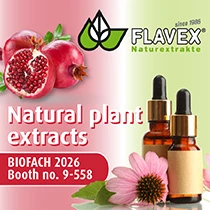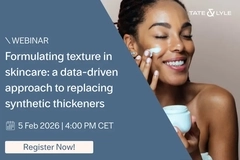Ectoin named the biotech active for skin protection and anti-aging

Ectoin is becoming one of the most sought after active ingredients in the personal care industry, highlighted by its increased use in new product formulations. Known as an extremolyte, this biotechnology-driven ingredient is a 100% natural molecule produced by extremophilic microorganisms — organisms that thrive in extreme environments such as salt lakes and deserts.
Ectoin acts as a protective compound, helping these microorganisms survive harsh conditions. In skin care, it forms a hydration shell around skin cells, protecting them from environmental stressors like UV radiation, pollution, and blue light. This creates long-lasting hydration, strengthens skin barriers, and reduces inflammation, making ectoin a valuable ingredient for sensitive and aging skin products.
Personal Care Insights speaks to René Schmitz technical sales and marketing manager at Bitop AG, a Germany-based biotechnology company. Bitop AG is the original manufacturer of ectoin and has expanded its manufacturing capacity in recent years to meet the increasing global demand for the ingredient.
“Ectoin’s ability to address modern skin care concerns while aligning with scientific and ethical values has secured its position as a trendsetter in personal care. It serves as a prime example of how biotechnology and nature-inspired solutions are shaping the industry’s future,” Schmitz says.
How has ectoin shaped trends in the personal care industry?
Schmitz: Ectoin showcases unique multifunctional properties and has influenced several skin- and personal care trends. With the growing demand for multifunctional skin care products, ectoin's versatility resonates with consumers looking for simplified skin care routines with fewer but more effective ingredients.
Among its scientifically proven benefits are protection against environmental stressors (UV, pollution, blue light), skin barrier repair, hydration, and soothing and anti-inflammatory properties. Its gentle yet effective properties align with consumers’ increasing awareness of sensitive skin issues and the clean beauty trend. Additionally, the scientific backing of ectoin’s efficacy reinforces its credibility among increasingly informed consumers.
Ectoin meets the demand for bio-based, scientifically advanced ingredients. These are highly valued by both the industry and consumers for their proven efficacy, sustainability, and innovative research supporting their development.
Furthermore, its environmentally friendly production process, using microorganisms adapted to extreme environments, supports the industry’s shift toward sustainability and ethical ingredient production.
What makes ectoin a standout ingredient compared to other protective or soothing agents?
Schmitz: Ectoin stands out as a powerful protection and repair agent in the personal care industry due to its unique properties and versatility, which set it apart from other commonly used ingredients. Through a simple yet effective physical mode of action, ectoin forms a hydration shell, the so-called “Ectoin Hydro Complex,” on the skin. This property strengthens the skin barrier and provides long-lasting hydration. While ingredients like hyaluronic acid are renowned for their hydrating properties, ectoin offers a more comprehensive solution combining hydration with protective and reparative functions.
.jpg) Ectoin stands out as a powerful protection and repair agent in the personal care industry.Ectoin not only reduces damage but has a long-term effect in helping the skin adapt and recover from environmental and oxidative stress. Its broad-spectrum protection against external stressors includes UV rays, pollution and blue light, providing holistic defense for the skin.
Ectoin stands out as a powerful protection and repair agent in the personal care industry.Ectoin not only reduces damage but has a long-term effect in helping the skin adapt and recover from environmental and oxidative stress. Its broad-spectrum protection against external stressors includes UV rays, pollution and blue light, providing holistic defense for the skin.
This is also connected to preventing the formation of wrinkles and reducing the appearance of fine lines by protecting against oxidative damage. Compared to many peptides or antioxidants that target specific mechanisms like collagen stimulation or free radical neutralization, ectoin delivers broader anti-aging benefits.
In addition to its protective properties, ectoin can calm irritation, reduce redness, and promote skin recovery without the risk of sensitization or side effects. Its soothing efficacy is comparable to well-known ingredients like allantoin or panthenol but has the added benefit of cellular-level protection and repair.
Extensive scientific research supports ectoin’s benefits in skin care and medical care. Only a few other ingredients, including popular actives like niacinamide or ceramides, have been studied as extensively.
Are there any emerging applications of ectoin in the personal care industry?
Schmitz: Ectoin plays a significant role in reducing inflammaging. The term “inflammaging” combines inflammation and aging, describing how persistent, subclinical inflammation accelerates the aging process, leading to visible signs such as wrinkles, sagging, redness, and loss of skin elasticity.
The inflammaging trend in skin care highlights the growing focus on addressing chronic, low-grade inflammation associated with aging skin.

Ectoin ia a valuable ingredient for sensitive and aging skin products.
Emerging applications for ectoin include hair and scalp care products targeting inflammation and sensitivity and professional-grade skin care designed to complement dermatological treatments. Ultra-gentle formulations for conditions like rosacea, dermatitis, and post-acne recovery are also rising.
Additionally, there is an increase in combination products, such as calming moisturizers and barrier creams featuring ectoin. Multipurpose skin care and makeup hybrids, like foundations and setting sprays, are also gaining popularity for their added skin-soothing benefits.
What advancements in ectoin production or application can we expect in the coming years?
Schmitz: With ongoing advancements in fermentation processes, biotechnology companies are expected to enhance production efficiency further, reduce costs, and minimize environmental impact. These continuous optimizations will enable scalable and sustainable production of ectoin, addressing the growing global demand.
As production becomes more cost-effective, ectoin will become accessible for a wider range of applications, including mass-market skin care products, broadening its appeal.
Further research into the interaction between ectoin, the skin, and the natural microbiome might unlock new possibilities for innovative applications. This exploration could lead to novel uses in microbiome-friendly formulations or targeted skin care solutions.
Additionally, advancements in encapsulation technologies are expected to play a pivotal role in the future of ectoin applications. Controlled-release systems will ensure prolonged activity and sustained hydration throughout the day, maximizing its benefits and enhancing its performance in personal care products.













